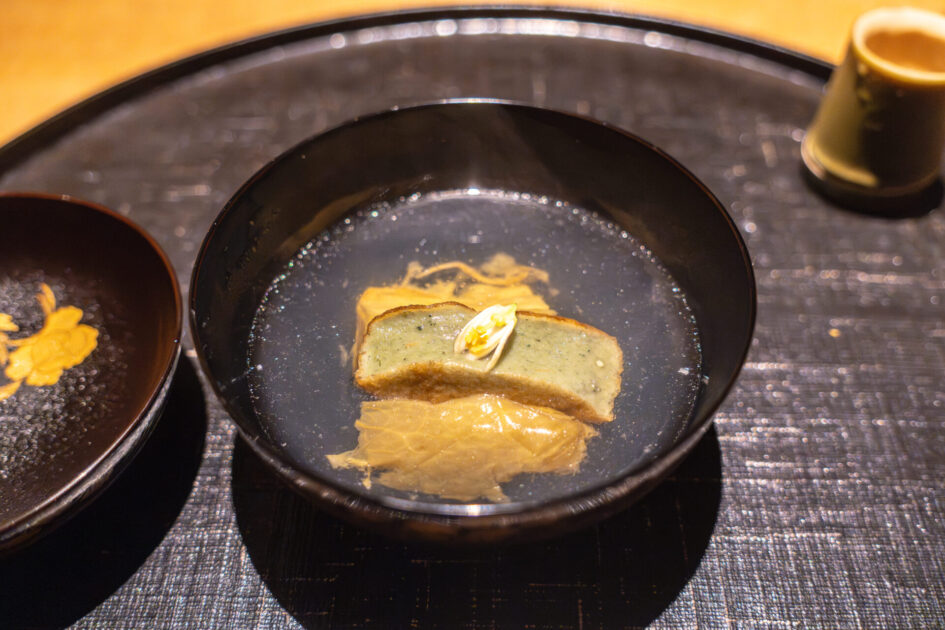※This article contains affiliate links. If you purchase a product through these links, we may receive a commission.
CONTENTS
About Ippongi Ishibashi
Concept
Tucked away in a quiet residential neighborhood of Hirao, Fukuoka, Ippongi Ishibashi exudes a serene presence. At first glance, it appears to be a modest sukiya-style house, but once inside, you are welcomed by an omakase experience that reimagines the traditional flow of kaiseki and sushi in a unique and refined way.
At the heart of the cuisine is freshly shaved dashi. Using different types of dried fish—arabushi, karebushi, and mejimaguro-bushi—the chef carefully shaves them to order, drawing out the most fragrant and umami-rich moment of the broth. Layered upon this base are seasonal vegetables, fresh seafood, hand-prepared dishes, and delicate nigiri, each one joining the previous like a natural breath—creating a calm rhythm course by course.
The intimate space features a six-seat counter and a private room. The interior is characterized by the soft scent of wood and intentional negative space. It’s a setting that quietly straightens your posture—not formal, but focused. The warm, graceful presence of the okami (hostess) brings a sense of ease and comfort to the room.
This is a restaurant that cherishes both the act of tasting dashi and the experience of dining itself, offering a thoughtful response to the way we eat in the modern age.
About the Chef – Yasutaka Ishibashi
Chef Yasutaka Ishibashi, the owner and head chef of Ippongi Ishibashi, was born in Fukuoka. He began his culinary career at the age of 18, starting his training at Wakuden, a respected kaiseki restaurant in Kyoto’s Kōdai-ji district. Over five years, he developed a deep understanding of traditional Japanese cuisine—learning to handle ingredients with care, perceive the seasons, and master the aesthetics of movement.
He then spent another five years at Umi, a renowned Edomae sushi restaurant in Aoyama, Tokyo, dedicating himself to the art of nigiri. After further honing his craft at Kaiseki Kamimura in Mie, Ishibashi returned to his hometown and opened his own restaurant in 2018, bringing with him over 13 years of experience.
The omakase he offers, centered around freshly shaved dashi, is the result of a chef fluent in both washoku and sushi traditions. His dishes are never overly elaborate, yet they carry a quiet strength and sincerity. Rather than asking, “How can I elevate this ingredient?”, he seems to ask, “How will the guest feel this moment?”
“My biggest goal,” says Chef Ishibashi, “is for guests to leave saying, ‘That was a truly enjoyable time.’” His calm and sincere personality permeates every dish and every interaction, shaping the very atmosphere of Ippongi Ishibashi.
Accolades
- Ippongi Ishibashi was awarded one Michelin star in the Michelin Guide Fukuoka 2019, a clear sign of its excellence in the field of Japanese cuisine and sushi in the region.
- It has also received a “3 Toques” rating in the Gault & Millau Kyushu edition, and has been featured in every issue from 2022 through 2025.
- The restaurant continues to be recognized for its consistently high standards in flavor, atmosphere, and service, earning it a place on Tabelog’s “Japan Restaurant Awards – Japanese Cuisine WEST 2025” with a Bronze Award. All key categories—including food, service, ambiance, and value—maintain a rating of 4.1 or higher.
- Ippongi Ishibashi has also been featured in leading publications such as Kateigaho, often praised as a “hard-to-book, highly sought-after restaurant.” Signature dishes like the “uni tamago-toji don” (sea urchin over rice in a gently cooked egg) are particularly celebrated.

Dining Prelude
Exterior & Entrance
Discreetly located in a corner of a residential area, Ippongi Ishibashi is housed in a sukiya-style building reminiscent of a traditional machiya townhouse. So unassuming that first-time visitors might walk right past it, its quiet elegance is a reflection of the restaurant’s aesthetic philosophy.
Step through the lattice door and you’ll find a stone path flanked by subtle landscaping. The manicured green of bamboo and maple reflects the shifting seasons with gentle beauty. From behind the noren curtain, a soft glow and tranquil silence greet you.
As the bustle of the outside world fades, you sense that beyond this door lies a poised, deeply considered experience.
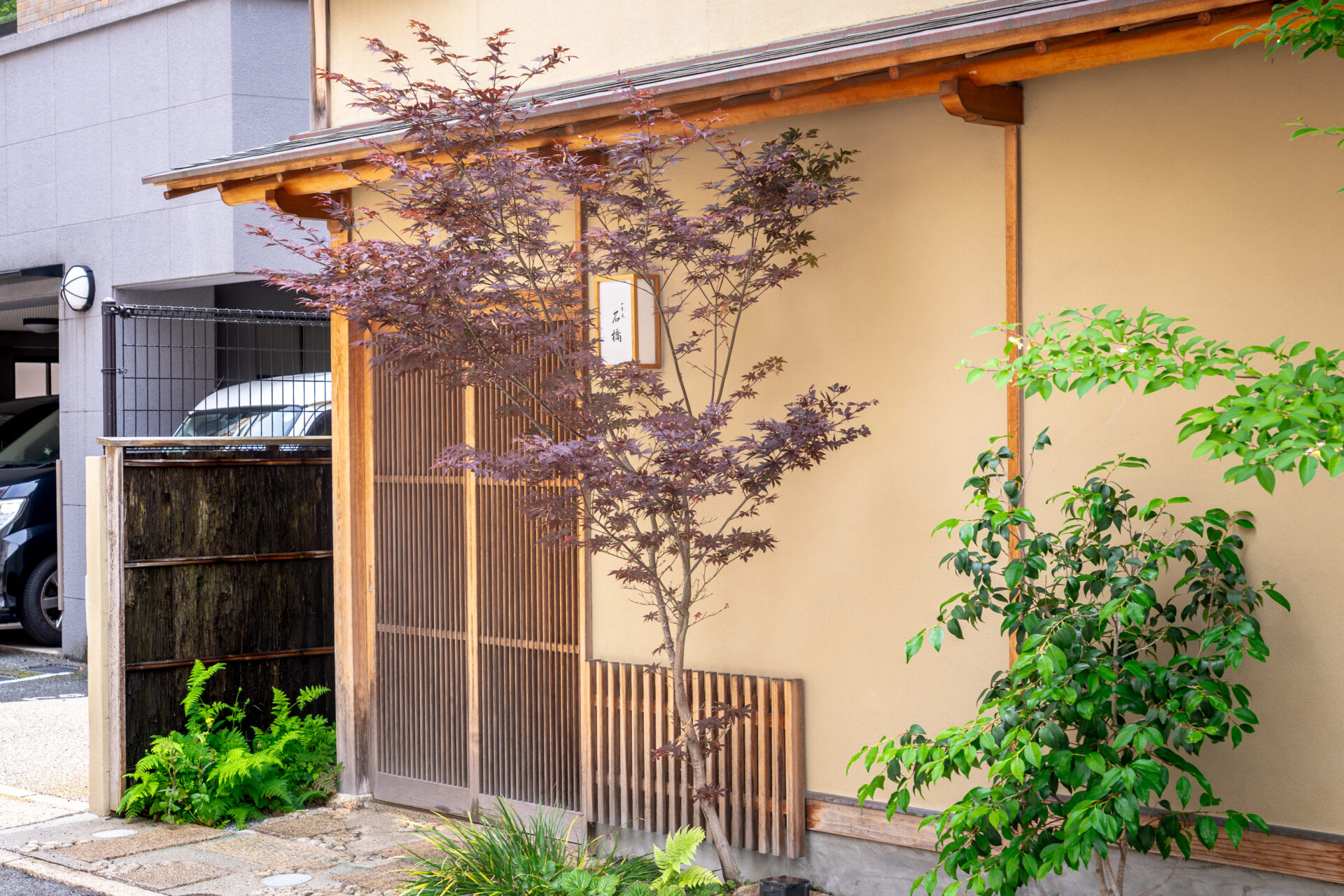
Dining Space
Inside, the restaurant offers a six-seat counter and a private room—both crafted for unhurried, quiet dining tailored to your group or occasion.
This time, we took a seat at the counter. A single slab of hinoki wood serves as the stage, with black lacquered trays set in perfect order. Directly in front, the open kitchen is precisely arranged. You experience the rising steam, the rhythm of the chef’s knife, the scent of shaved katsuobushi—each moment engaging all five senses in a deeply immersive way.
The private room, on the other hand, resembles a tranquil tea room, with soft light filtering through shoji screens and a tokonoma alcove adorned with a scroll. Whichever space you choose, you are fully enveloped in the world of Ippongi Ishibashi.
Menu Presentation
Ippongi Ishibashi offers omakase courses only, by reservation, both at lunch and dinner. Each course features seasonal ingredients, freshly shaved dashi, and sushi as its core elements. Three pricing tiers are available depending on the volume and ingredients.
Lunch Omakase Course – ¥11,000 (incl. tax)
The most popular option. A full and satisfying experience, even during lunch.
Dinner Omakase Course – ¥18,000 (incl. tax)
The standard dinner course. A well-balanced presentation of sushi and washoku, including seasonal specialties.
Premium Omakase Course – ¥22,000 (incl. tax)
For those seeking even greater depth and rarer seasonal ingredients.
For this visit, we chose the ¥11,000 lunch course. Despite the time constraints of midday dining, the course offers a complete journey—featuring the nuanced flavor of dashi, the craftsmanship of sushi, and a satisfying finale of grilled dish, rice, and dessert. It’s a showcase of Chef Ishibashi’s signature approach.
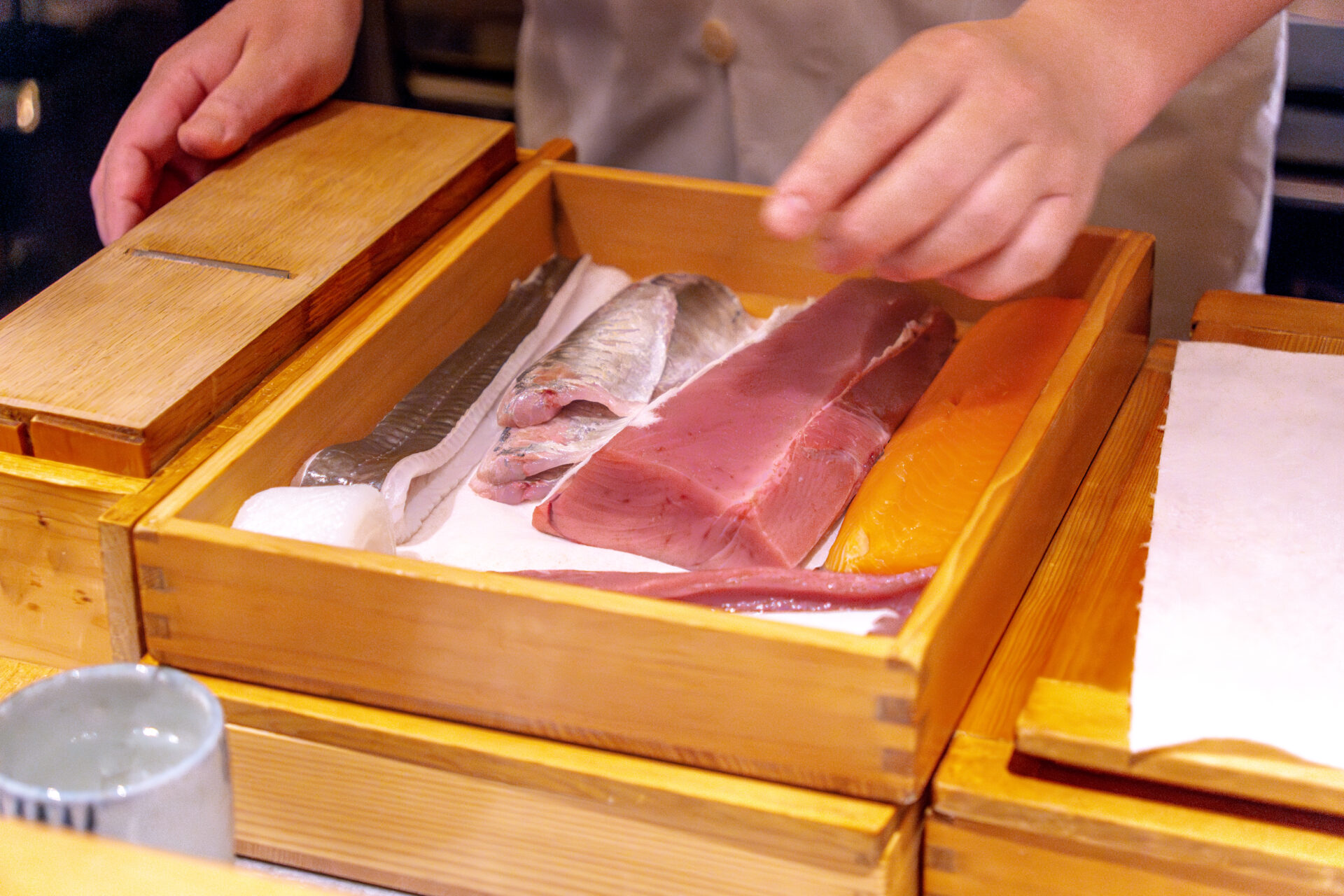
Starter Drink
We began with a glass of draft beer—an easy toast to ease into the stillness of the early afternoon. As we sipped, a calm anticipation began to settle in.
Next came a cup of kōsen-yu, a warm infusion scented with fresh green shiso. It gently warmed the body from within, awakening the senses.
Then, an aperitif was served in a bamboo vessel—a refreshing sip with a soft sweetness, offering a graceful transition into the meal ahead. A quiet yet deliberate prologue to what was to come.
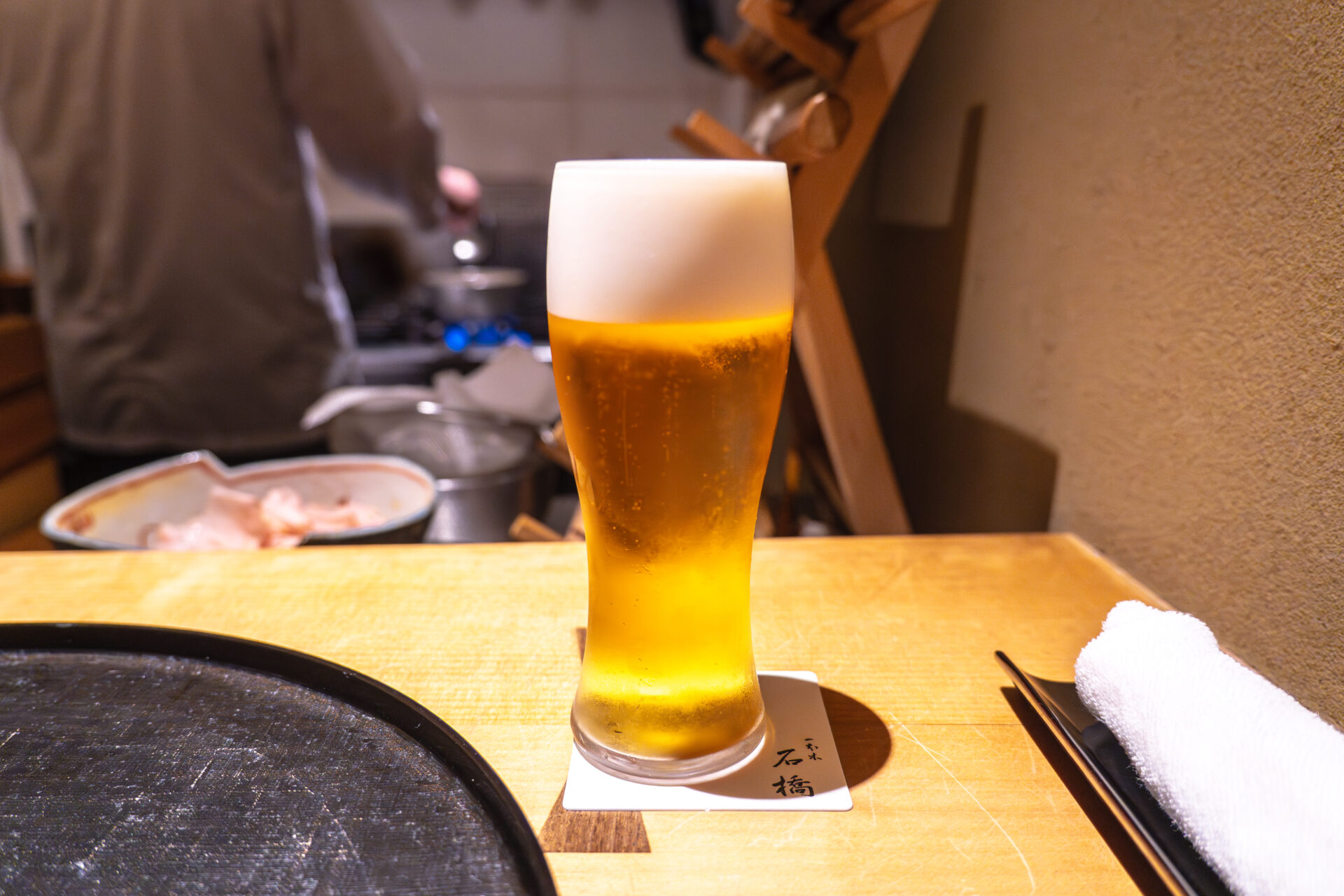
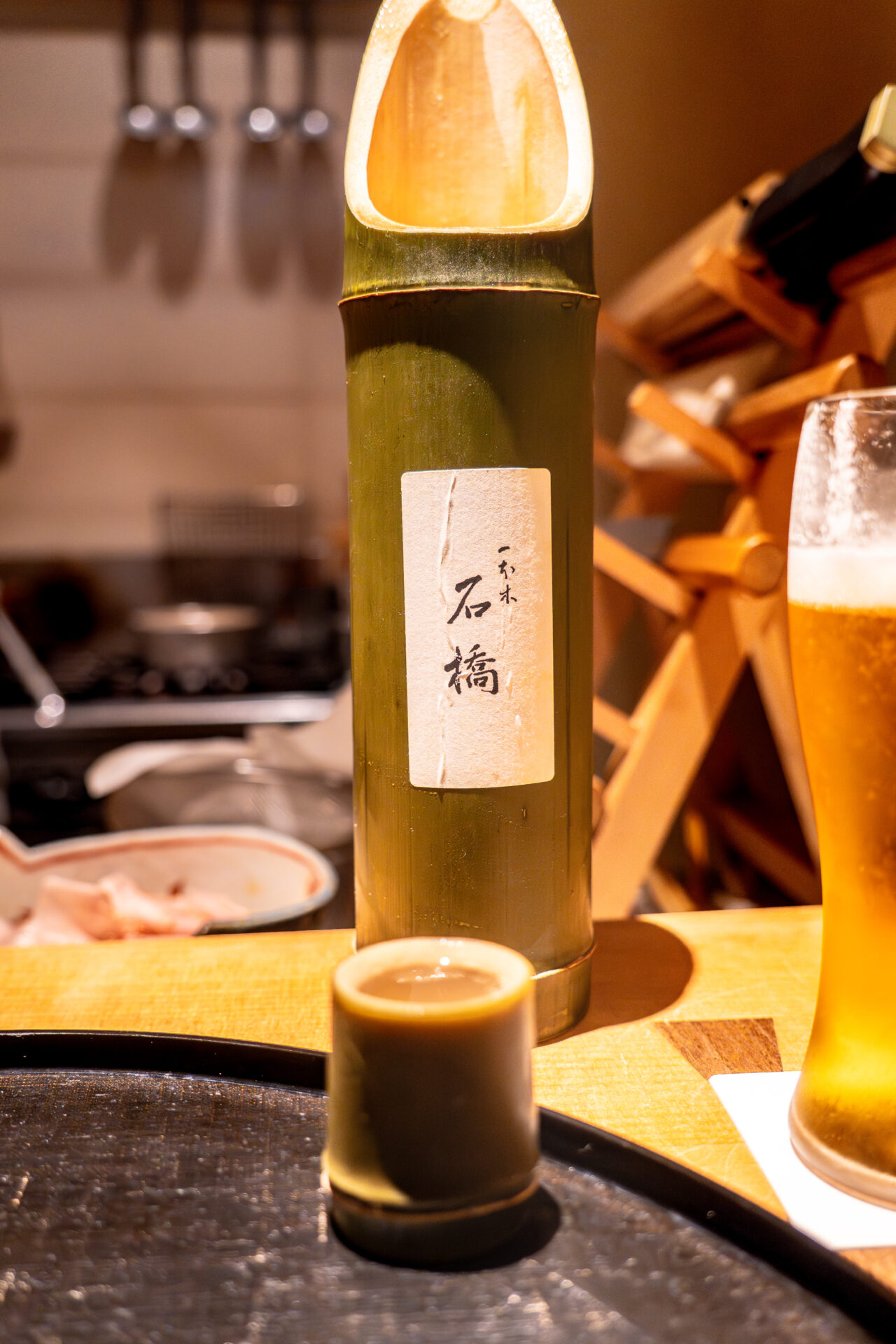

The Dining Experience
Chilled Chawanmushi with Purple Sea Urchin
The meal began with a chilled chawanmushi—a delicate savory egg custard. A gentle layer of sweet corn purée rested on top, crowned with a serving of murasaki uni (purple sea urchin) from Munakata.
The silky texture of the custard paired with the natural sweetness of the corn creates a soft, mellow base. The briny richness and oceanic aroma of the uni add depth, allowing the individual ingredients to gently intertwine.
Cool yet deeply flavorful, the lingering aftertaste is elegant—an understated dish that quietly signals the arrival of early summer.
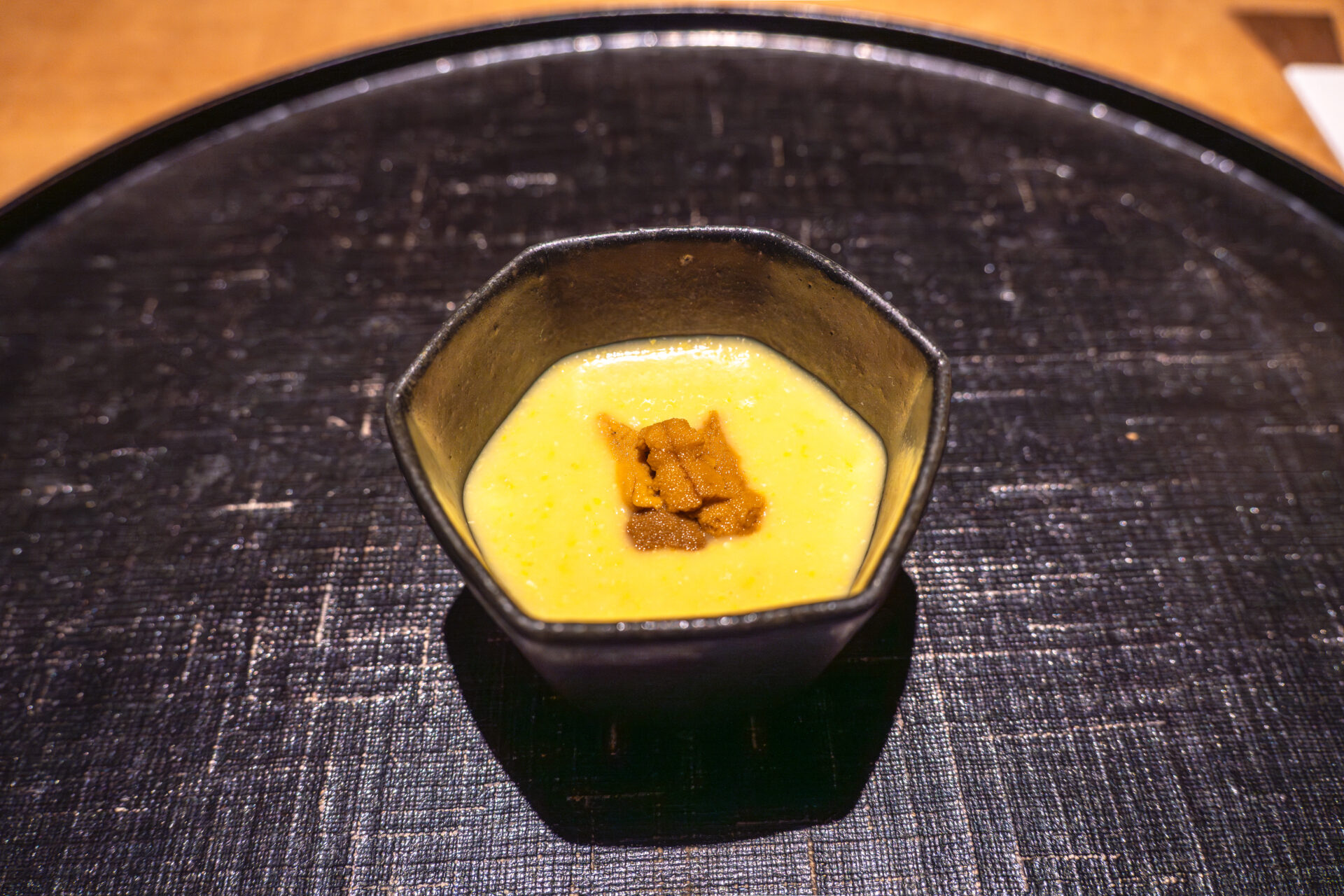
Deep-Fried Round Eggplant in Dashi (Oranda-ni)
Lifting the lid of the bowl releases a fragrant plume of freshly shaved bonito dashi. Inside, a single piece of maru nasu(round eggplant from Osaka) is served oranda-ni style—lightly fried, then gently simmered in the broth.
The eggplant, tender and full of flavor, soaks in the dashi and melts slowly in the mouth. The sweetness brought out by frying blends beautifully with the umami of the fresh bonito, resulting in a dish that quietly seeps into the senses—a perfectly composed bowl.
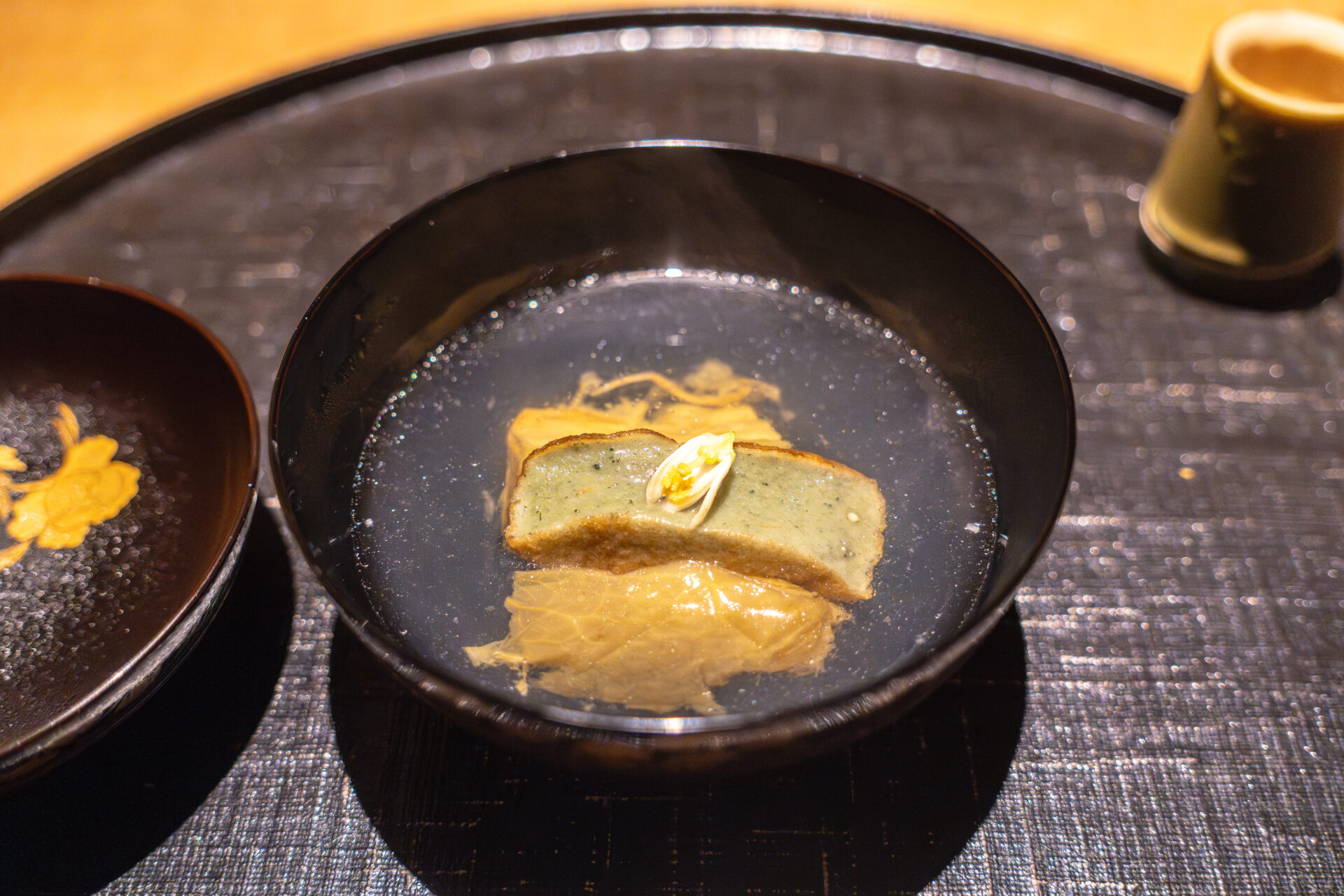
Lightly Poached Splendid Alfonsino from the Goto Islands
The fish course featured kinmedai (splendid alfonsino) from the Goto Islands. While the chef typically avoids Kyushu-sourced kinmedai, he was impressed by the quality of this particular catch.
The skin was lightly poached (yubiki) and served with a simple wasabi soy sauce. The slight char of the skin and the tender sweetness of the flesh stood out, showcasing expert technique in both cooking and knife work.
A dish that speaks to the chef’s respect for ingredients—quiet, minimal, and resolute.
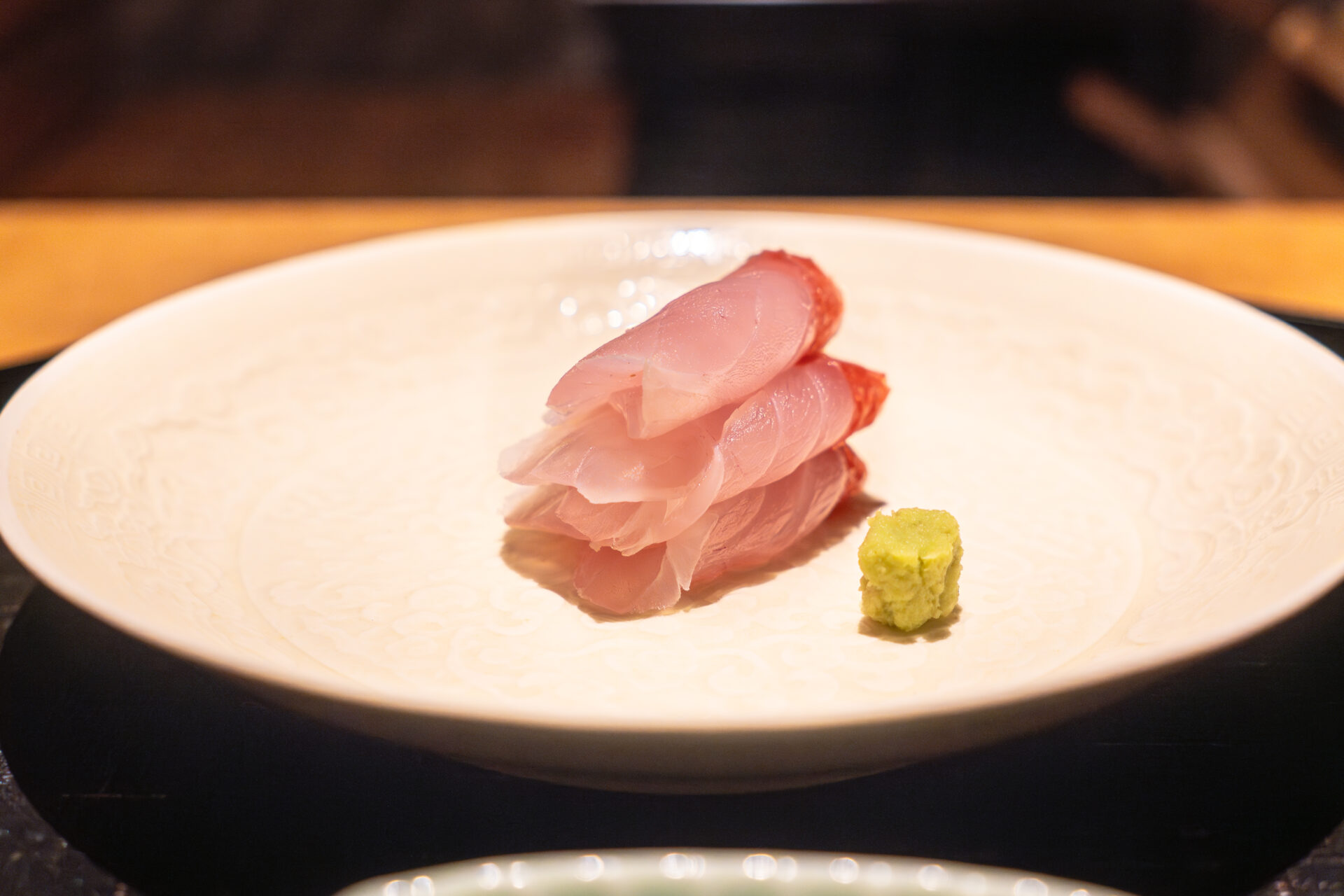
Nigiri ①: Seared Spanish Mackerel from Ise Bay
The first nigiri was sawara (Spanish mackerel) from Ise Bay. As the chef explained, “The fat is light, but the flavor is deep.”
Without excess oil, the seared skin released a savory aroma, and the fish’s natural umami spread gently across the palate. Light yet impactful, this first piece marked a clear shift into the sushi segment of the course.

Nigiri ②: Horse Mackerel from the Genkai Sea
Next came aji (horse mackerel) from the Genkai-nada. Rich with fat but never overpowering, the slightly cured fish had a brightness and clarity.
The harmony between the fat of the aji and the sushi rice was exceptional. The temperature, seasoning, and texture of the shari (sushi rice) were perfectly calibrated. Neither fish nor rice overwhelmed the other—this was a piece of quiet precision and balance.
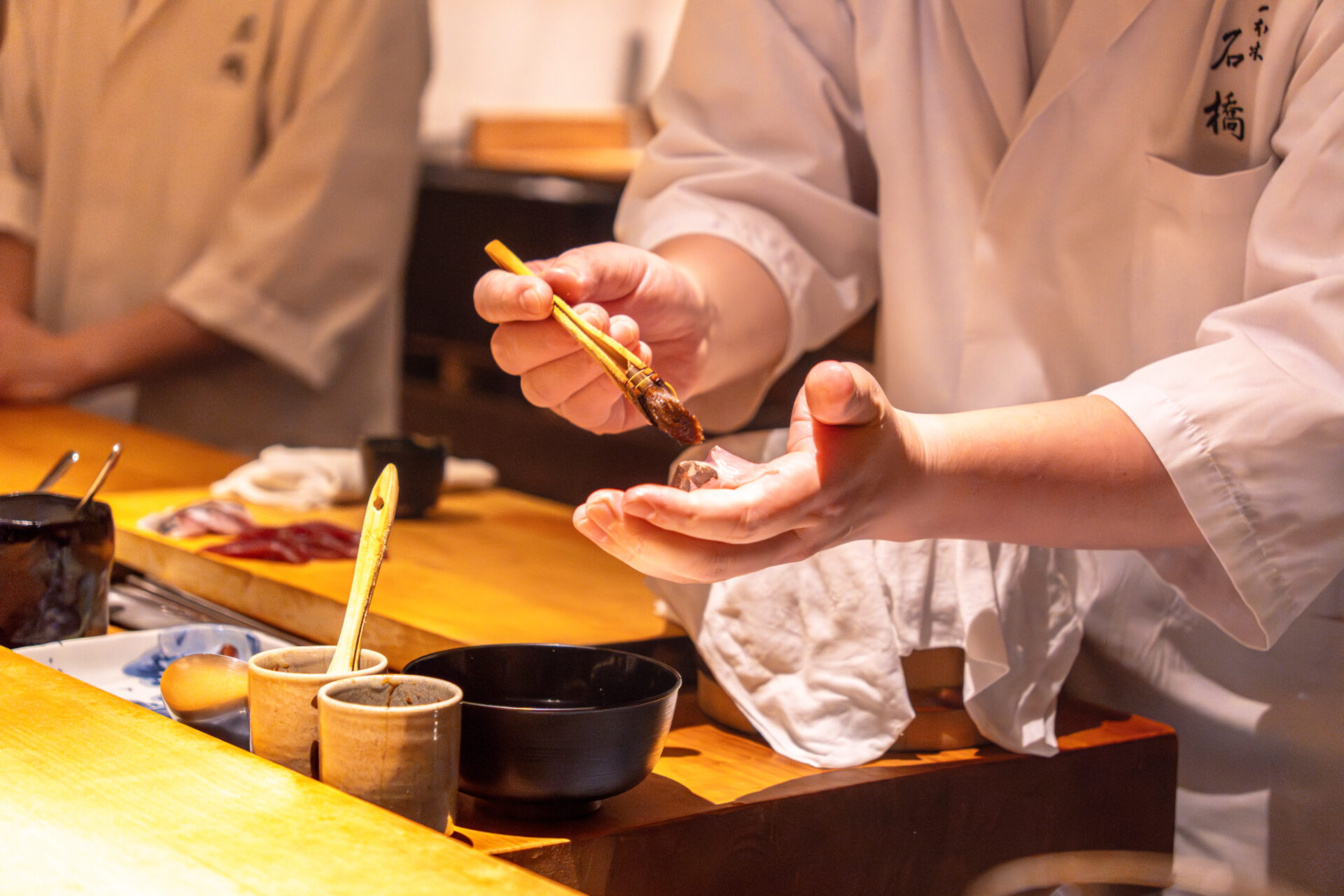
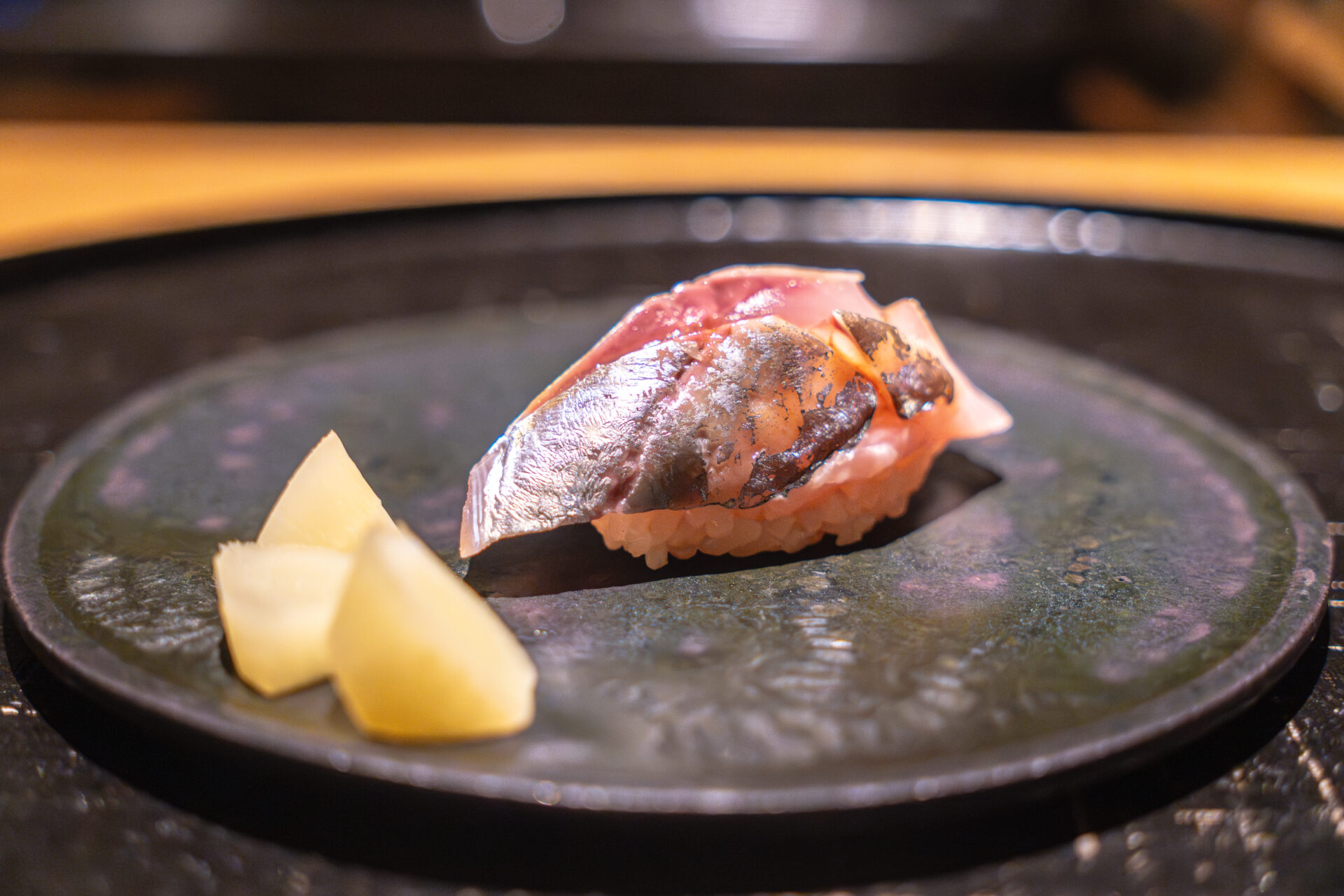
Nigiri ③: Marinated Young Tuna from Iki
The third nigiri featured meji maguro (young tuna) from Iki, marinated in soy. The marinade brought out its delicate umami while adjusting the acidity and saltiness.
Gently placed atop the rice, the slice dissolved effortlessly on the tongue. Light but well-defined, it introduced a moment of calm—a soft counterpoint within the sushi sequence.
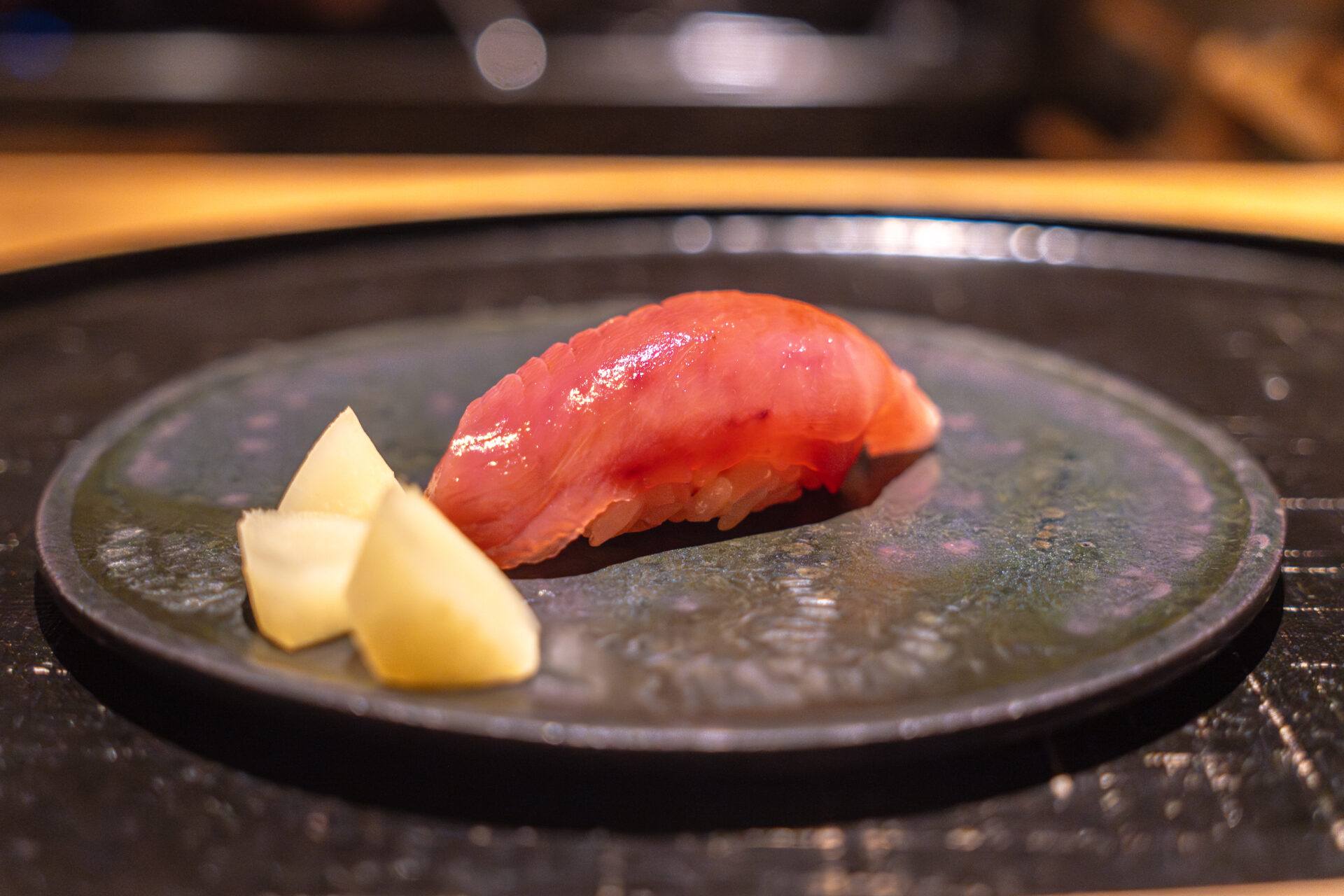
Simmered Vegetables with Sesame: Burdock Root, Young Corn, Asparagus
After the trio of nigiri came a small bowl of sesame-dressed vegetables. Aromatic young burdock, sweet young corn, and the fresh greenness of asparagus, paired with soft atsuage tofu, all brought together with a deep, nutty sesame flavor.
This plate, grounded in the scent of soil and spring greenery, gently re-centered the rhythm of the meal—offering a soft segue into its latter half.
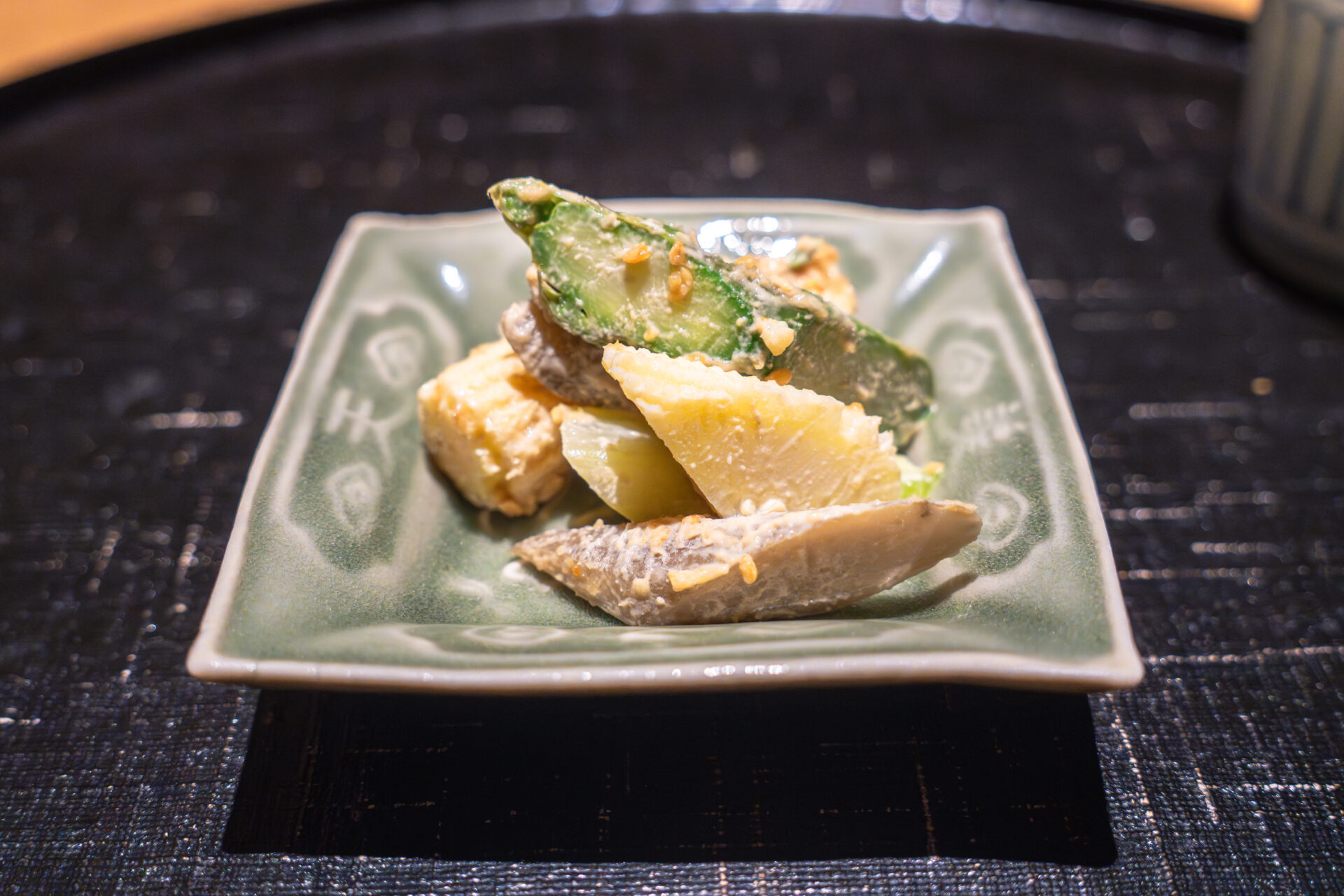
Lake Biwa Ayu and Taro with Ginger Sauce
This warm dish featured ayu (sweetfish) from Lake Biwa, paired with simmered satoimo (taro) and topped with a delicate sauce made from fresh ginger.
The subtle bitterness of the young ayu hinted at the transition from spring to summer, while the smooth, warm taro grounded the dish. The ginger sauce added an aromatic lift, tying the elements together into a composed, quietly assertive expression of the season.
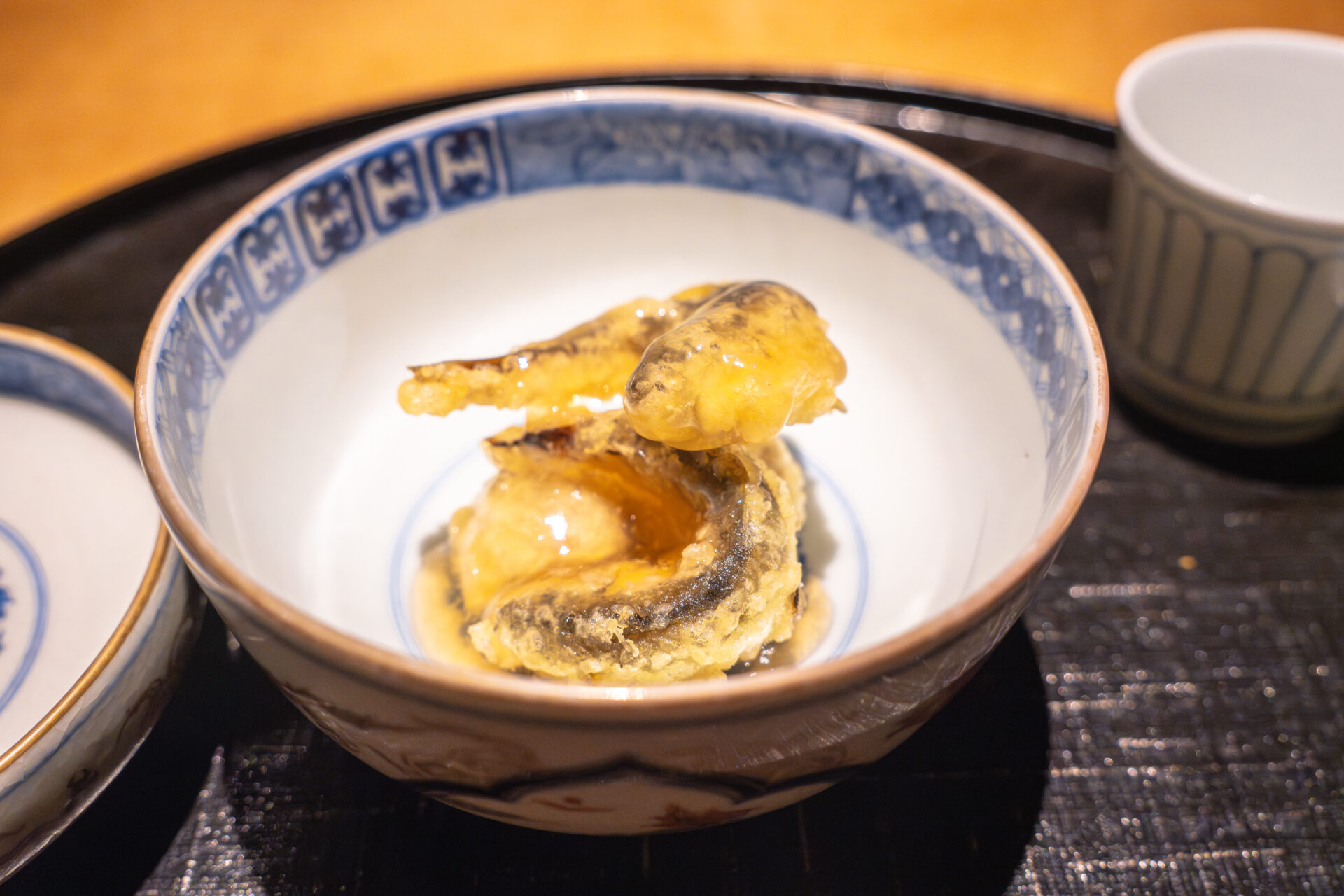
Zōsui with Pickled Plum and Shiso
A nibana-style rice porridge made with half-cooked rice grains formed the base for this comforting dish, accented with the tartness of pickled ume and the refreshing aroma of shiso.
The gentle steam carried the sweet scent of freshly cooked rice, while the plum and shiso cleansed the palate. It was a soft, elegant transition from the heightened focus of the earlier courses into a place of calm.
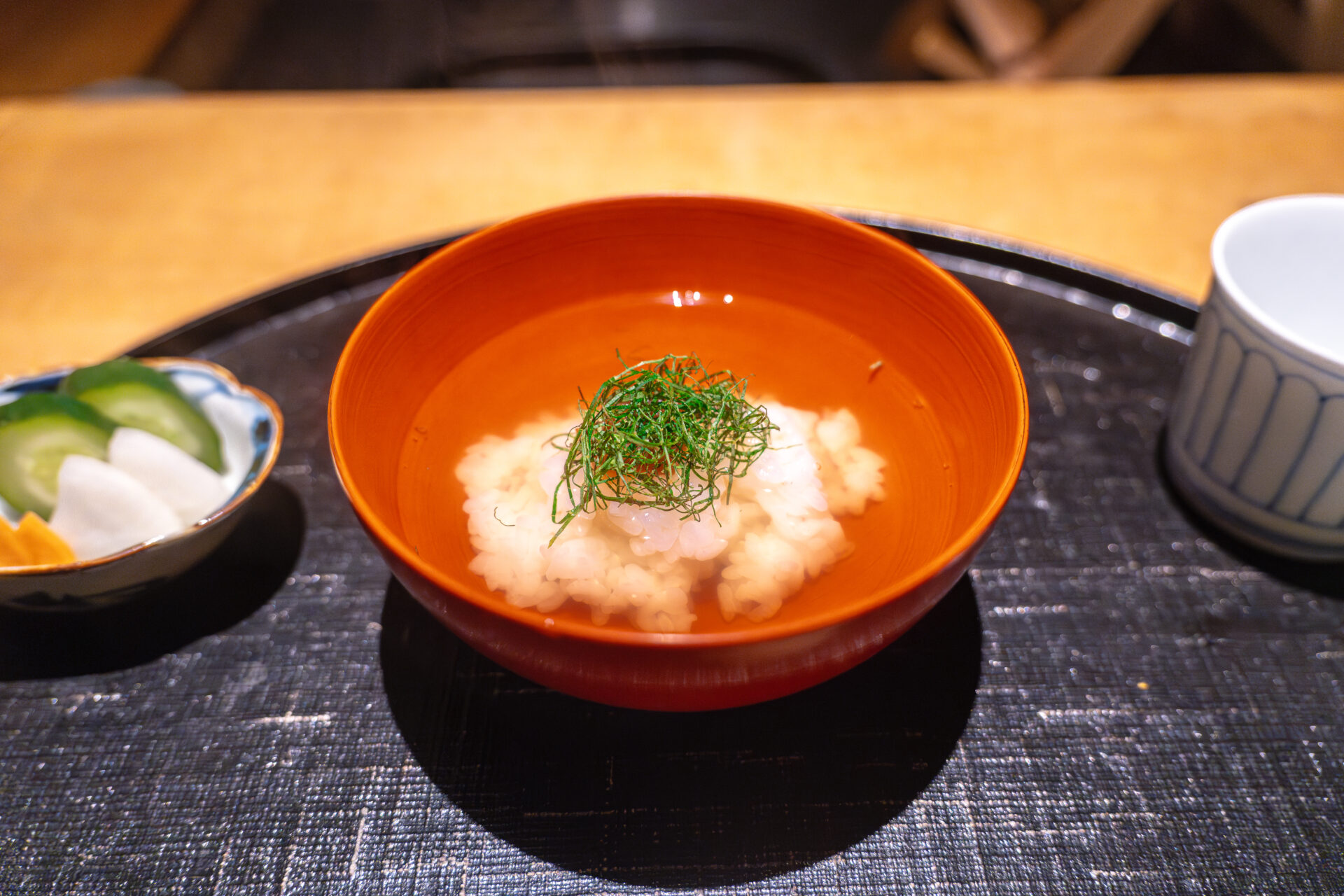
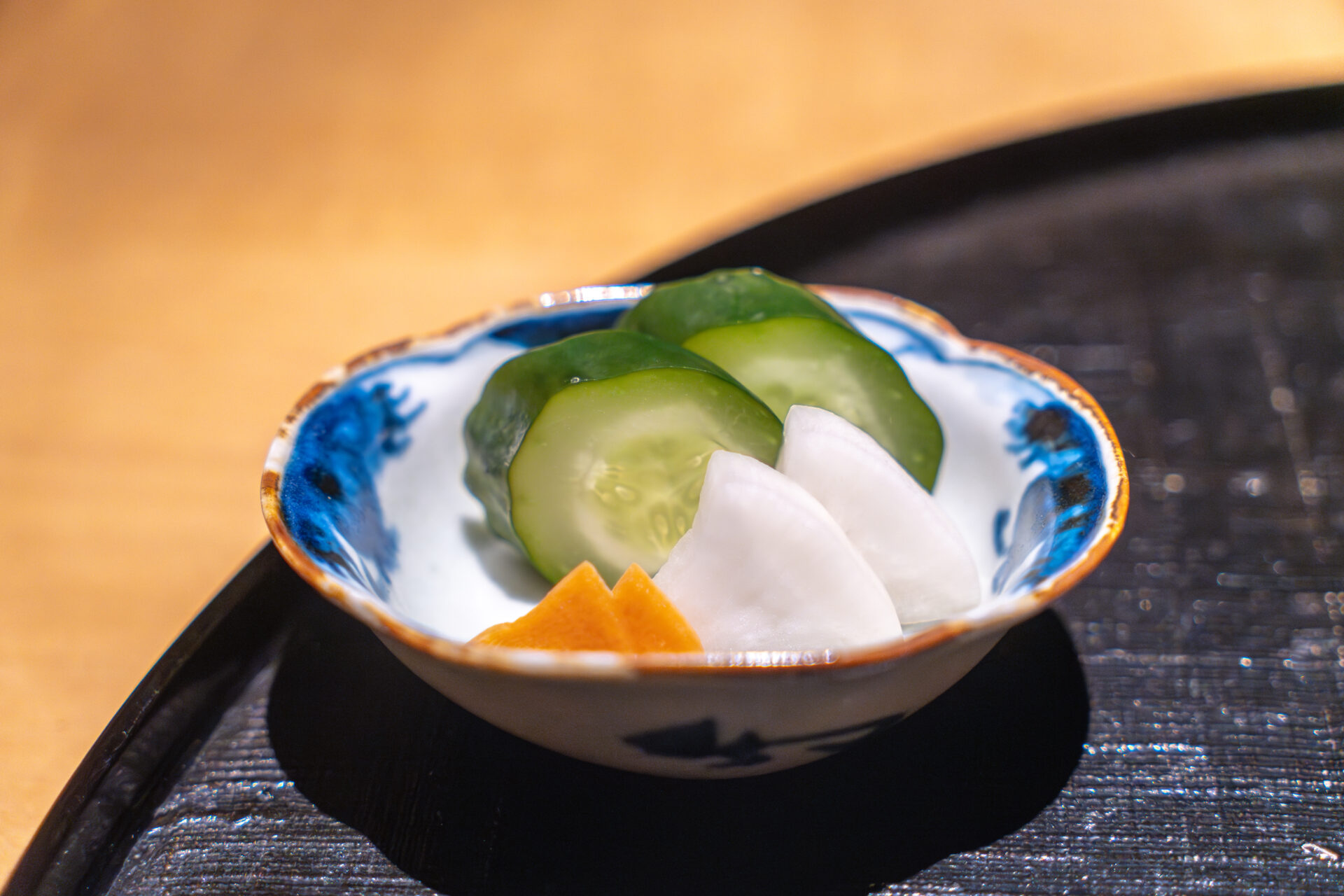
Steamed Rice with Freshly Shaved Bonito Flakes
The final savory course was a simple bowl of steaming white rice topped with freshly shaved katsuobushi (bonito flakes). A few drops of soy sauce brought the elements together.
The heat of the rice caused the bonito flakes to dance atop the bowl, releasing a fragrant cloud of umami. It was a moment where the space itself seemed to exhale—a quiet, satisfying close.
The accompanying tsukemono pickles added a touch of salt to round out the flavor, leaving a sense of deep contentment.
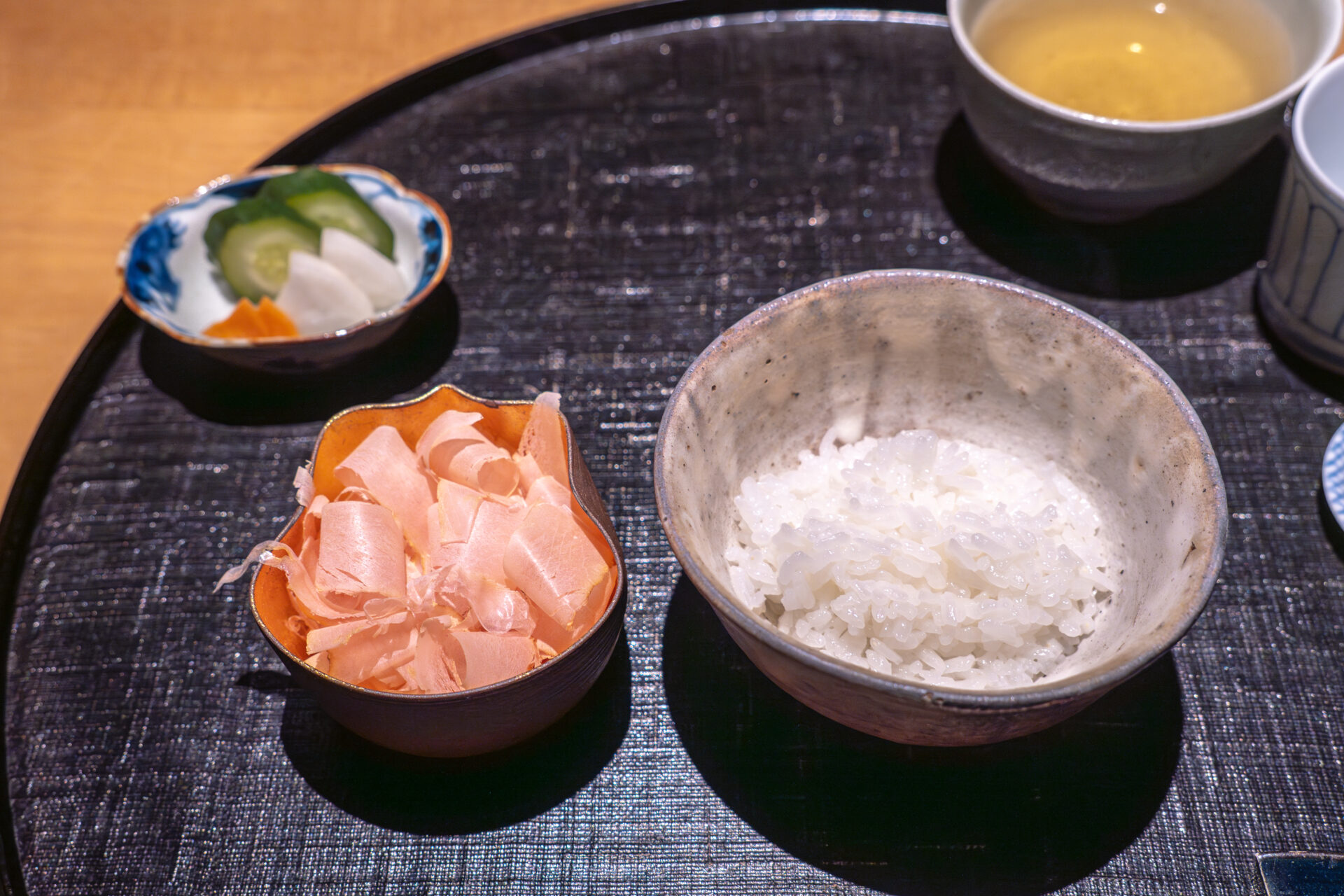
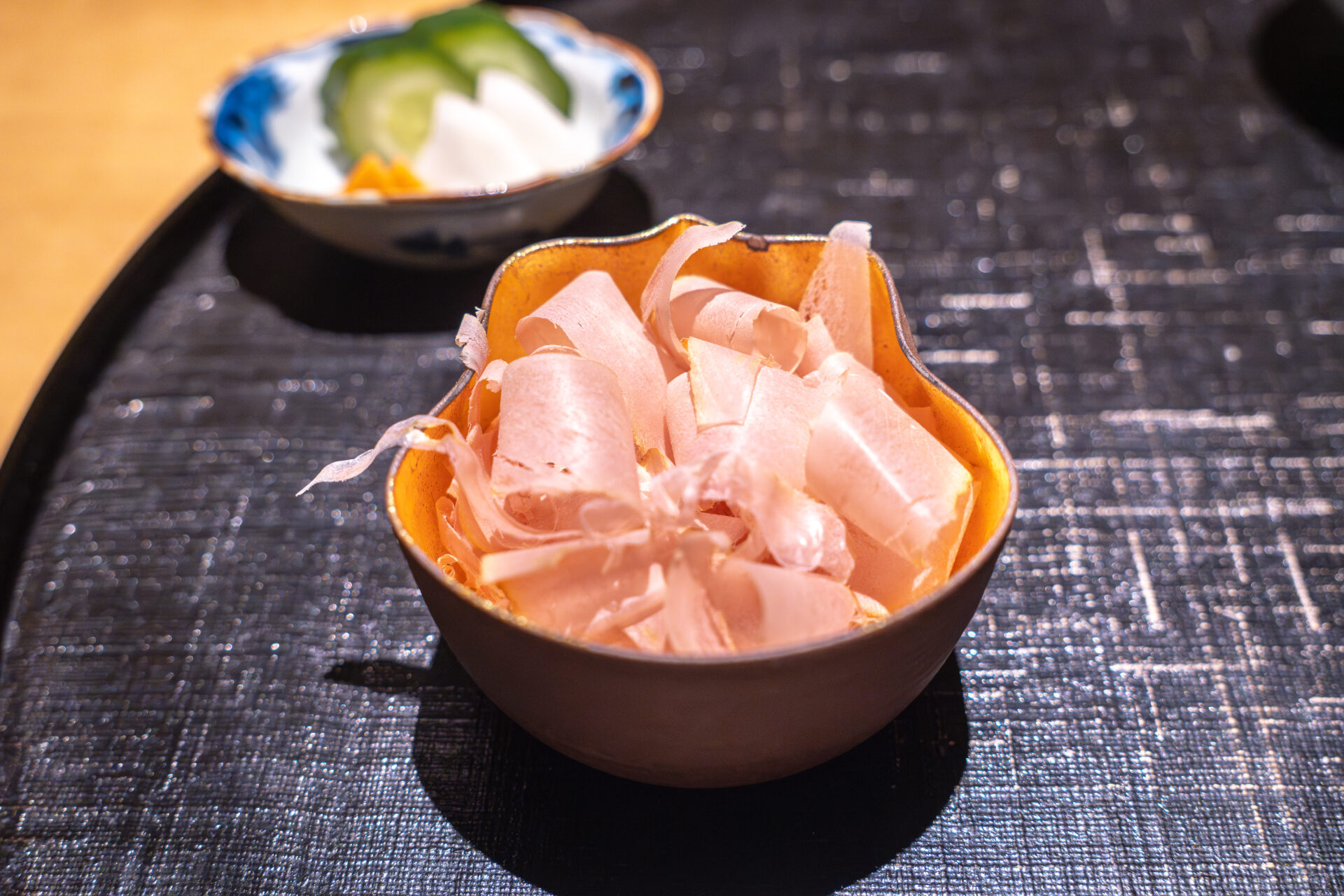
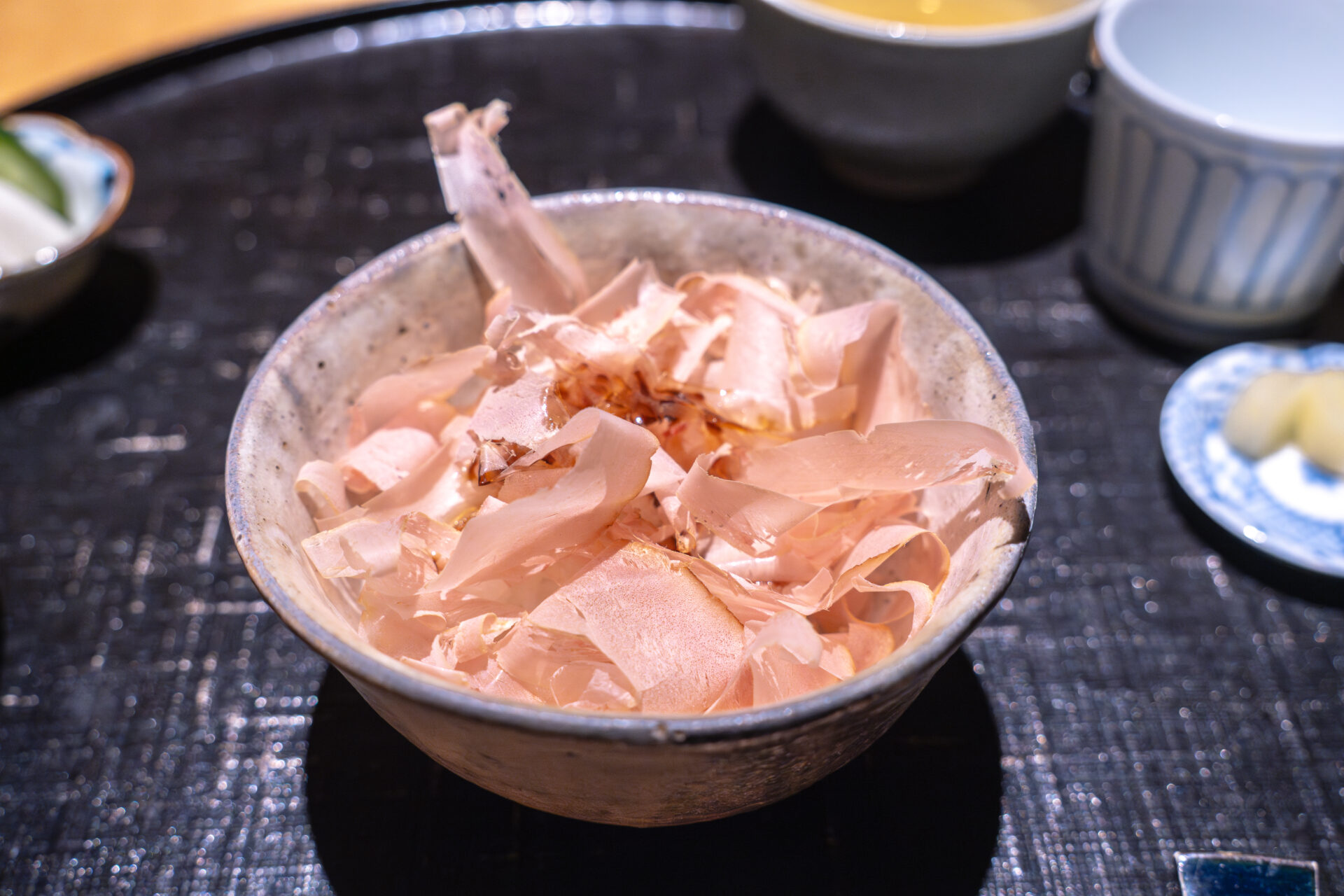
Second Bowl: Tuna Flakes over Rice
A second bowl followed—this time with freshly shaved maguro-bushi (tuna flakes). Compared to the bonito, the tuna had a deeper aroma and richer flavor.
Even using the same rice, the experience was entirely distinct. The way the aroma lifted with the soy sauce, the way the flakes moved in the steam—it was a quiet joy that beckoned another bite.
This subtle contrast left a gentle mark in memory—a closing chapter written in umami.
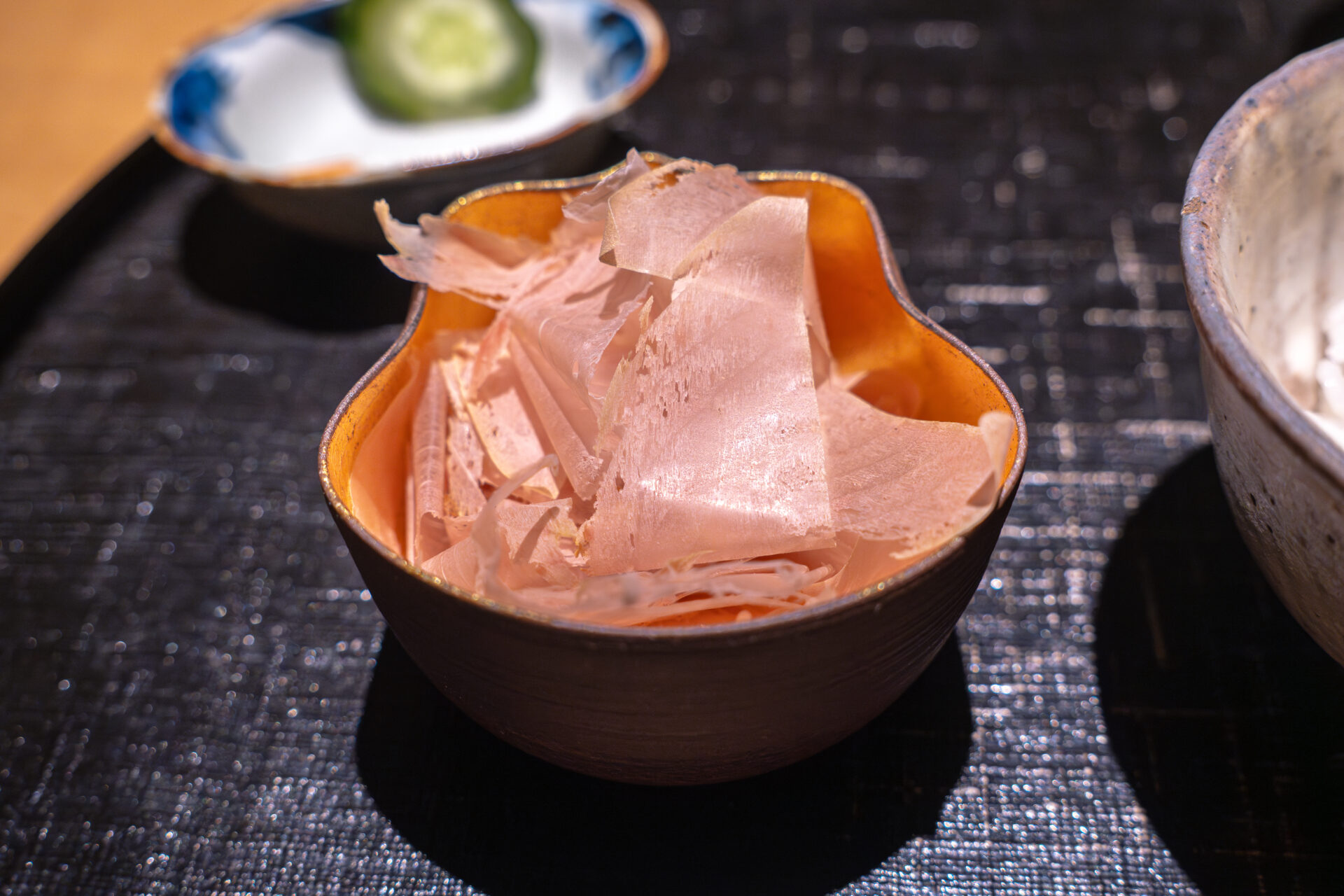
Dessert & Finale
Grilled Lotus Root Mochi
Before dessert came a savory-sweet interlude: grilled renkon mochi (lotus root mochi), inspired by the chef’s training at Kyoto’s Wakuden.
The soft, chewy texture of grated lotus root met the crispness of the grilled surface, revealing natural sweetness and a subtle saltiness with every bite.
A dish infused with memory, reimagined through the chef’s current sensibility—a reflection of time and training captured on a plate.
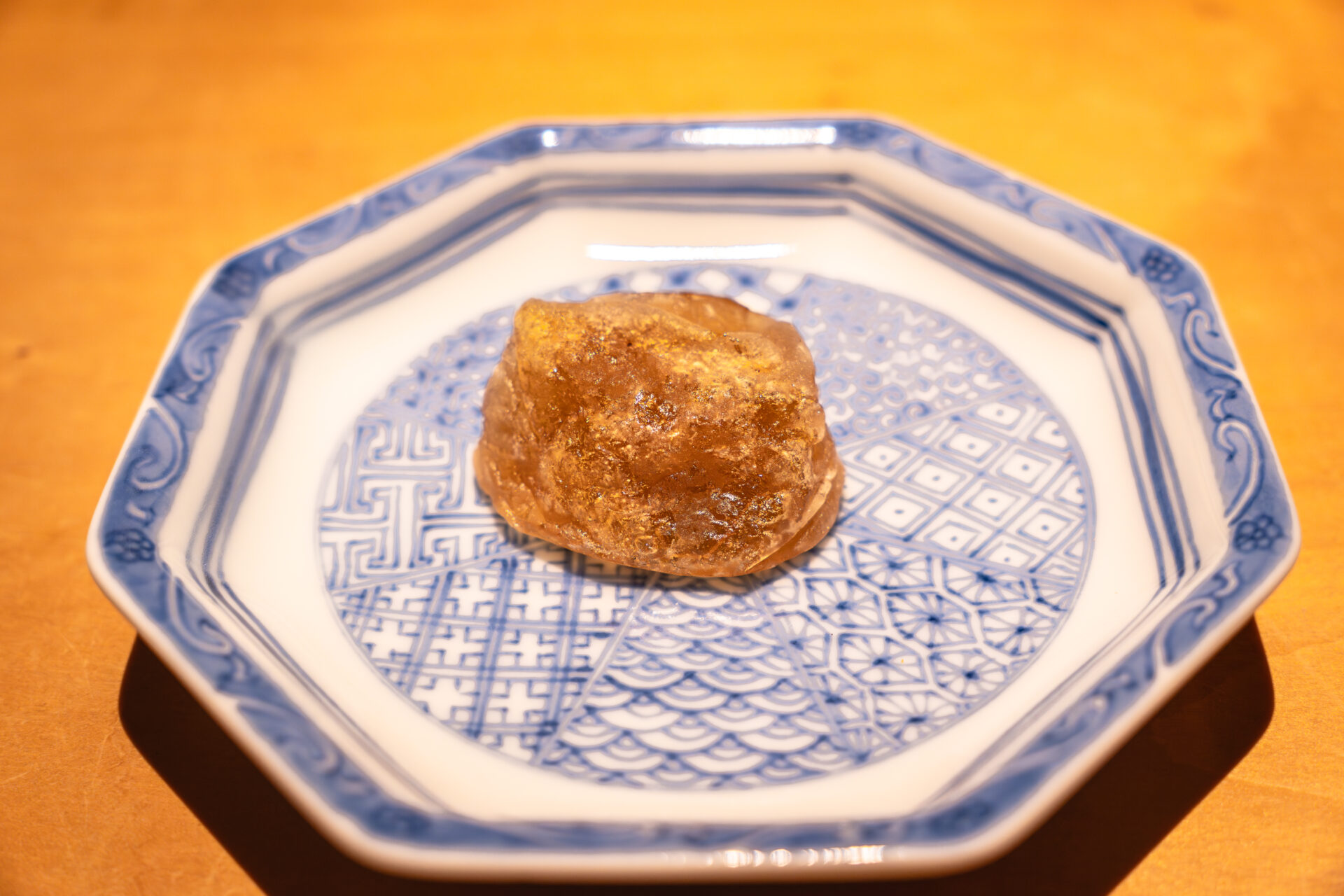
House-Made White Peach Ice Cream
The final dessert was a house-made white peach ice cream. Smooth and delicate, it delivered the gentle aroma and juicy sweetness of ripe peach in a single spoonful.
Unembellished and pure, it celebrated the natural flavor of the fruit, leaving a cool, graceful impression that echoed the tone of the entire meal.
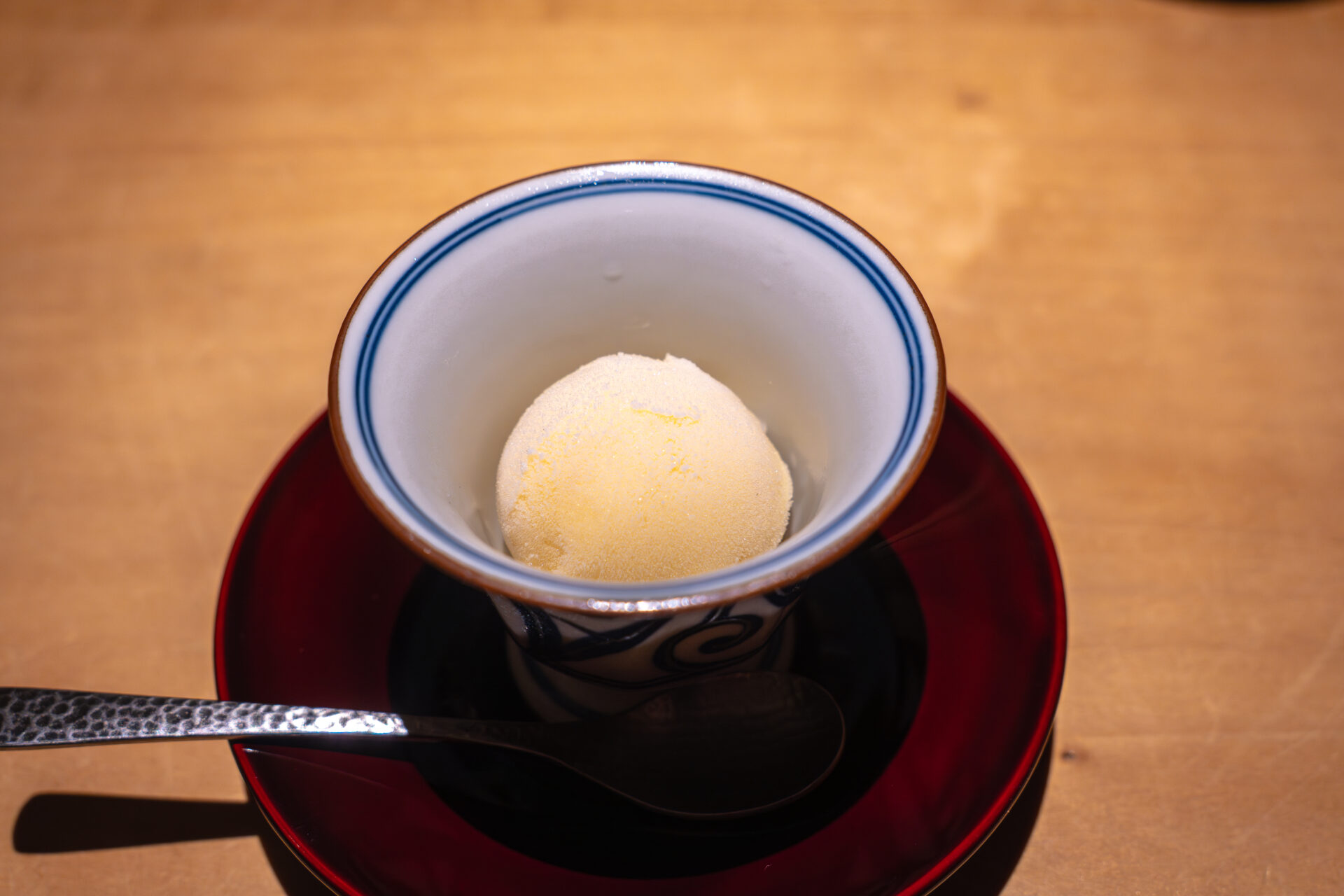
Closing: Matcha Whisked by the Okami
The meal ended with a quiet offering of matcha, whisked by the okami herself.
Presented with graceful, deliberate movements, the tea brought the meal to a peaceful close. The soft scent and bold bitterness gently tied together the memory of each dish, leading the guest into a moment of calm reflection.
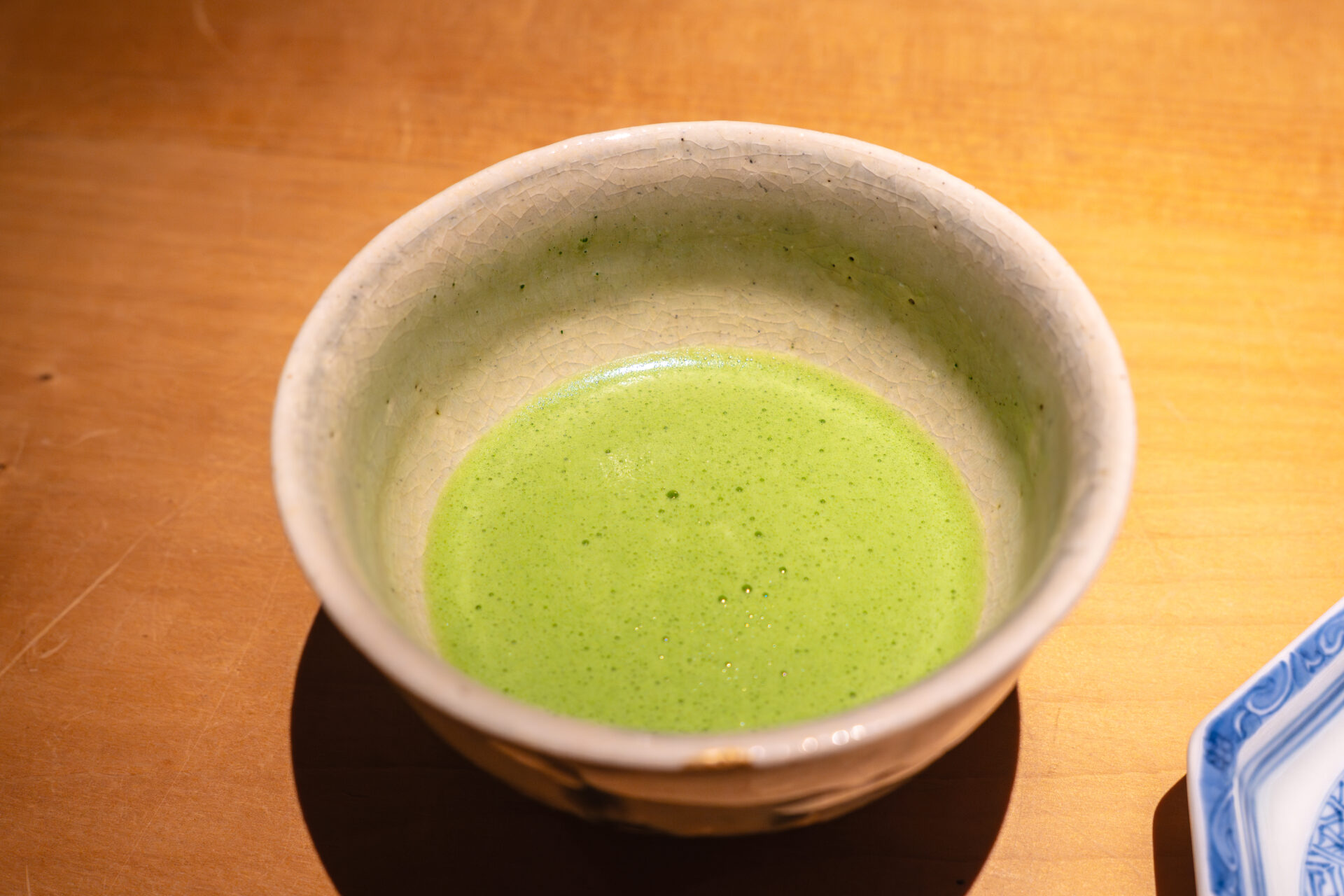
Summary & Impressions
Our meal at Ippongi Ishibashi began in the quiet calm of midday. From the initial kōsen-yu and aperitif, through dishes like the chilled chawanmushi, simmered eggplant, and three carefully selected nigiri, each course flowed naturally—never forced, always harmonious.
What left the strongest impression was the gentleness of the dashi and the delicate balance of the sushi. The three pieces of nigiri were thoughtfully curated, each showcasing its own distinct character and perfectly matched with the rice.
Wrapped in the chef’s skill and sincerity, and the okami’s gracious presence, the experience balanced both the focus and the relaxation that fine dining can offer. It was a truly enjoyable and fulfilling time.
This is a place that lingers in the memory—one you’ll want to return to as the seasons change.
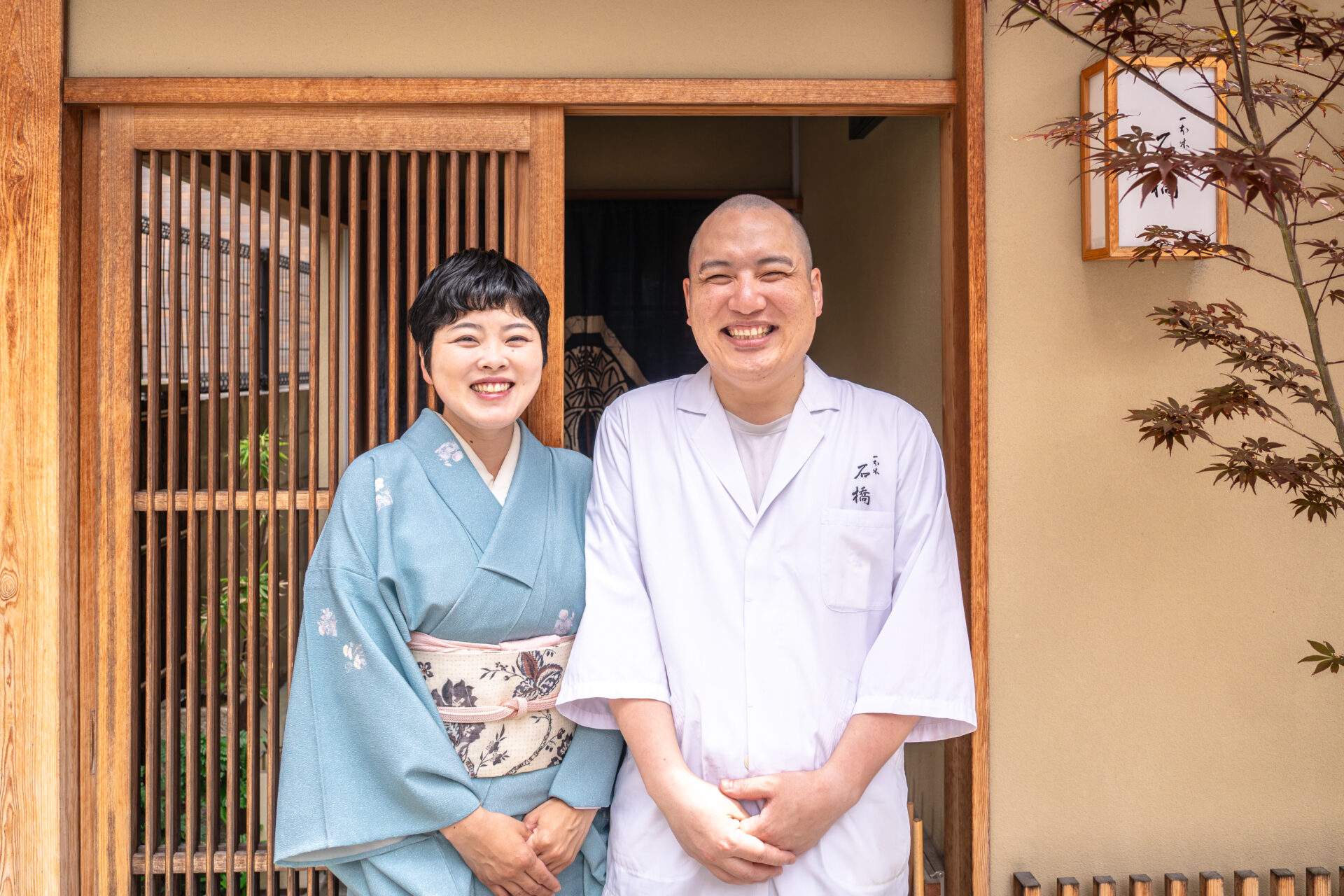
Reservations & Access
Reservations
Phone Booking
+81-92-534-7560 (Domestic: 092‑534‑7560)
Online Booking
Reservations are required in advance and can be made through platforms such as:
(Please note that most reservations are “request-based” and require confirmation from the restaurant.)
If you have any dietary restrictions or are bringing children, it is highly recommended to contact the restaurant beforehand.
Cancellation Policy
-
Same-day cancellations or no-shows: 100% charge
-
Day-before cancellations: 50–75% charge (varies depending on reservation platform)
Opening Hours
Lunch
12:00 PM – 3:00 PM (Last Order: 1:30 PM)
Dinner
6:00 PM – 10:00 PM (Last Order: 8:00 PM)
Closed irregularly
Location
Address
1-9-13 Hirao, Chūō-ku, Fukuoka-shi, Fukuoka, Japan
〒810-0014
Nearest Stations
-
Approx. 6–7 min walk from Nishitetsu Hirao Station (Nishitetsu Tenjin Ōmuta Line)
-
Approx. 8–10 min walk from Yakuin Station (Fukuoka Subway Nanakuma Line)
Parking
No on-site parking. Please use nearby coin-operated lots.
Seating, Payment, and Amenities
-
Total seats: 14 (6 counter seats + private room for up to 8 guests)
-
Credit cards accepted: VISA, MasterCard, JCB, American Express, Diners Club
-
Non-smoking throughout
-
Children welcome (private room only; prior consultation required)
- TAGS

